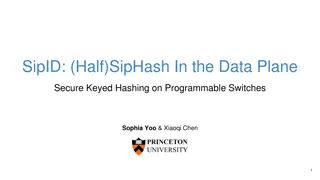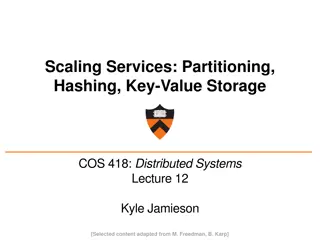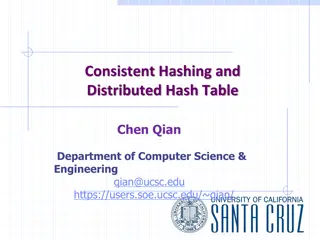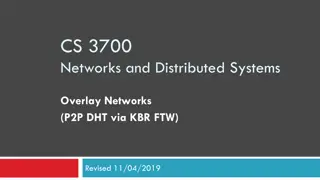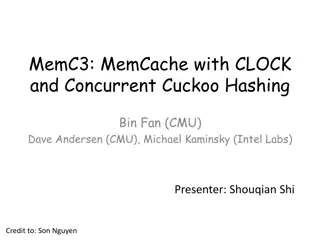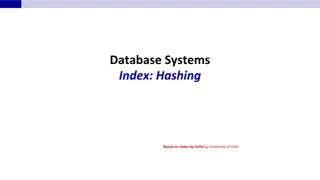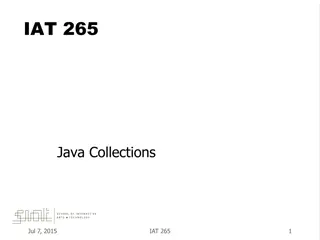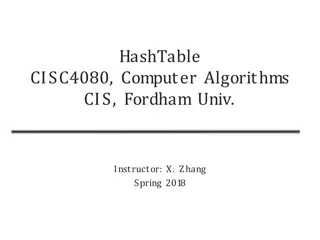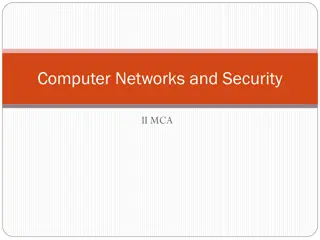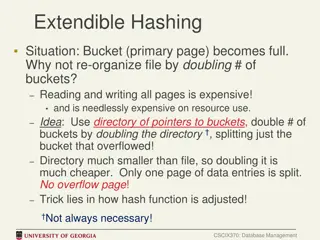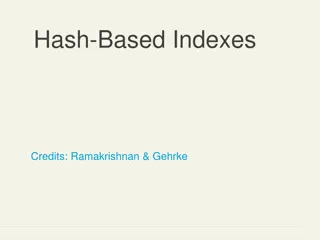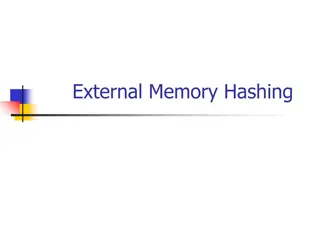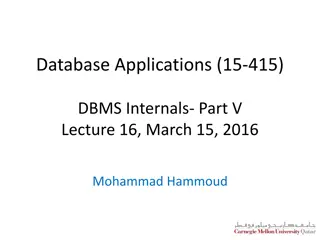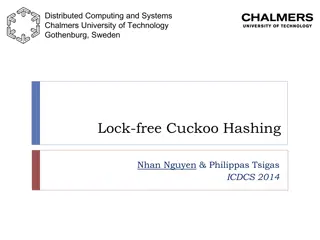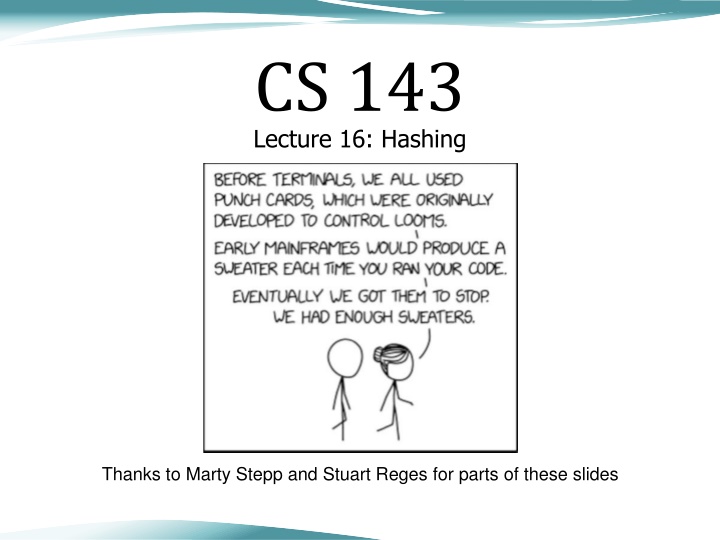
Efficient Hashing Techniques for Data Storage
Explore the concepts of hashing and collision resolution techniques for efficient data storage. Learn about hashing functions, hash tables, collision resolution algorithms, and their impact on add, search, and remove operations. Discover ways to optimize data storage and retrieval using hashing in programming.
Download Presentation

Please find below an Image/Link to download the presentation.
The content on the website is provided AS IS for your information and personal use only. It may not be sold, licensed, or shared on other websites without obtaining consent from the author. If you encounter any issues during the download, it is possible that the publisher has removed the file from their server.
You are allowed to download the files provided on this website for personal or commercial use, subject to the condition that they are used lawfully. All files are the property of their respective owners.
The content on the website is provided AS IS for your information and personal use only. It may not be sold, licensed, or shared on other websites without obtaining consent from the author.
E N D
Presentation Transcript
CS 143 Lecture 16: Hashing Thanks to Marty Stepp and Stuart Reges for parts of these slides
How to implement a set? Elements of a TreeSet (IntTree) are in BST sorted order. We need this in order to add or search in O(log N ) time. But it doesn't really matter what order the elements appear in a set, so long as they can be added and searched quickly. Consider the task of storing a set in an array. What would make a good ordering for the elements? index value 0 7 1 11 24 49 2 3 4 0 5 0 6 0 7 0 8 0 9 0 index value 0 0 1 11 2 0 3 0 4 5 0 6 0 7 7 8 0 9 24 49 2
Hashing hash: To map a value to an integer index. hash table: An array that stores elements via hashing. hash function: An algorithm that maps values to indexes. one possible hash function for integers: HF(I) I % length set.add(11); set.add(49); set.add(24); set.add(7); // 11 % 10 == 1 // 49 % 10 == 9 // 24 % 10 == 4 // 7 % 10 == 7 index value 0 0 1 11 2 0 3 0 4 5 0 6 0 7 7 8 0 9 24 49 3
Efficiency of hashing public static int hashFunction(int i) { return Math.abs(i) % elementData.length; } Add: set Search: check if Remove: set elementData[HF(i)] = i; elementData[HF(i)] == i elementData[HF(i)] = 0; What is the runtime of add, contains, and remove? O(1)! Are there any problems with this approach? 4
Collisions collision: When hash function maps 2 values to same index. set.add(11); set.add(49); set.add(24); set.add(7); set.add(54); // collides with 24! collision resolution: An algorithm for fixing collisions. index value 0 0 1 11 2 0 3 0 4 5 0 6 0 7 7 8 0 9 54 49 5
Probing probing: Resolving a collision by moving to another index. linear probing: Moves to the next index. set.add(11); set.add(49); set.add(24); set.add(7); set.add(54); // collides with 24; must probe index value 0 0 1 11 2 0 3 0 4 5 6 0 7 7 8 0 9 24 54 49 Is this a good approach? variation: quadratic probing moves increasingly far away 6
Clustering clustering: Clumps of elements at neighboring indexes. slows down the hash table lookup; you must loop through them. set.add(11); set.add(49); set.add(24); set.add(7); set.add(54); // collides with 24 set.add(14); // collides with 24, then 54 set.add(86); // collides with 14, then 7 index value value index 0 0 0 0 1 0 11 1 2 0 0 2 3 3 0 0 4 0 4 5 0 5 6 6 0 7 0 7 7 8 0 8 9 9 0 24 54 14 86 49 Now a lookup for 94 must look at 7 out of 10 total indexes. 7
Chaining chaining: Resolving collisions by storing a list at each index. add/search/remove must traverse lists, but the lists are short impossible to "run out" of indexes, unlike with probing index value 0 1 2 3 4 5 6 7 8 9 11 24 7 49 54 14 8
Hash set code import java.util.*; // for List, LinkedList public class HashIntSet { private static final int CAPACITY = 137; private List<Integer>[] elements; // constructs new empty set public HashSet() { elements = (List<Integer>[]) (new List[CAPACITY]); } // adds the given value to this hash set public void add(int value) { int index = hashFunction(value); if (elements[index] == null) { elements[index] = new LinkedList<Integer>(); } elements[index].add(value); } // hashing function to convert objects to indexes private int hashFunction(int value) { return Math.abs(value) % elements.length; } ... 9
Hash set code 2 ... // Returns true if this set contains the given value. public boolean contains(int value) { int index = hashFunction(value); return elements[index] != null && elements[index].contains(value); } // Removes the given value from the set, if it exists. public void remove(int value) { int index = hashFunction(value); if (elements[index] != null) { elements[index].remove(value); } } } 10
Rehashing rehash: Growing to a larger array when the table is too full. Cannot simply copy the old array to a new one. (Why not?) load factor: ratio of (# of elements ) / (hash table length ) many collections rehash when load factor .75 can use big prime numbers as hash table sizes to reduce collisions 0 1 2 3 4 5 6 7 8 9 10 11 12 13 14 15 16 17 18 19 24 7 49 11 54 14 11
Rehashing code ... // Grows hash array to twice its original size. private void rehash() { List<Integer>[] oldElements = elements; elements = (List<Integer>[]) new List[2 * elements.length]; for (List<Integer> list : oldElements) { if (list != null) { for (int element : list) { add(element); } } } } 12
Other questions How would we implement toString on a HashSet? How would we implement an Iterator over a HashSet? index value 0 1 2 3 4 5 6 7 8 9 11 24 7 49 54 current element: 24 current index: sub-index: 0 4 iterator 14 13
Hashing objects It is easy to hash an integer I (use index I % length ). How can we hash other types of values (such as objects)? All Java objects contain the following method: public int hashCode() Returns an integer hash code for this object. We can call hashCode on any object to find its preferred index. How is hashCode implemented? Depends on the type of object and its state. Example: a String's hashCode adds the ASCII values of its letters. You can write your own hashCode methods in classes you write. All classes come with a default version based on memory address. 14
Hash function for objects public static int hashFunction(E e) { return Math.abs(e.hashCode()) % elements.length; } Add: set Search: check if Remove: set elements[HF(o)] = o; elements[HF(o)].equals(o) elements[HF(o)] = null; 15
String's hashCode The hashCode function inside String objects looks like this: public int hashCode() { int hash = 0; for (int i = 0; i < this.length(); i++) { hash = 31 * hash + this.charAt(i); } return hash; } As with any general hashing function, collisions are possible. Example: "Ea" and "FB" have the same hash value. Early versions of the Java examined only the first 16 characters. For some common data this led to poor hash table performance. 16
Implementing a hash map A hash map is just a set where the lists store key/value pairs: // key value map.put("Marty", 14); map.put("Jeff", 21); map.put("Kasey", 20); map.put("Stef", 35); index value 0 1 2 3 4 5 6 7 8 9 "Jeff" 21 "Marty" 14 "Stef " 35 "Kasey" 20 Instead of a List<Integer>, write an inner Entry node class with key and value fields; the map stores a List<Entry> 17

